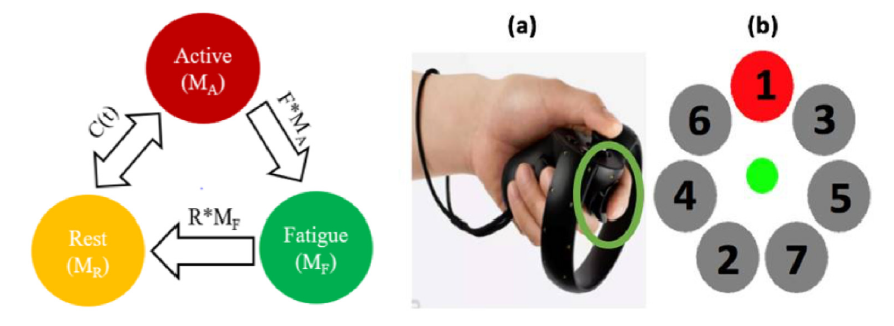Interaction in mid-air can be fatiguing. A model-based method to quantify cumulative subjective fatigue for such interaction was recently introduced in HCI research. This model separates muscle units into three states: active (Ma) fatigued (Mf) or rested (Mr) and defines transition rules between states. This method demonstrated promising accuracy in predicting subjective fatigue accumulated in mid-air pointing tasks. In this paper, we introduce an improved model that additionally captures the variations of the maximum arm strength based on arm postures and adds linearly-varying model parameters based on current muscle strength. To validate the applicability and capabilities of the new model, we tested its performance in various mid-air interaction conditions, including mid-air pointing/docking tasks, with shorter and longer rest and task periods, and a long-term evaluation with individual participants. We present results from multiple cross-validations and comparisons against the previous model and identify that our new model predicts fatigue more accurately. Our modeling approach showed a 42.5% reduction in fatigue estimation error when the longitudinal experiment data is used for an individual participant’s fatigue. Finally, we discuss the applicability and capabilities of our new approach.
Advanced modeling method for quantifying cumulative subjective fatigue in mid-air interaction
Authors: Ana Villanueva, Sujin Jang, Wolfgang Stuerzlinger, SatyajitAmbike, Karthik Ramani
International Journal of Human-Computer Studies, 102931
https://doi.org/10.1016/j.ijhcs.2022.102931

Ana Villanueva
Ana Villanueva is a first year DPhD student in the School of Mechanical Engineering at Purdue. She obtained her bachelor's degree from the University of Kansas in Mechanical Engineering (2016). Her research interests involve the biomechanics behind human-computer interactions, data visualization and data analysis. Other research interests include the biomechanics of the human spine, the mechanical behavior of self-healing polymers and the design of walking aids for elderly patients. In her free time, Ana enjoys traveling with her friends, learning new languages, watching Dr. House and visiting her home country, Peru. She is a member of the Society of Women Engineers (SWE) and a member of Pi Tau Sigma, the International Mechanical Engineering Honor Society.
